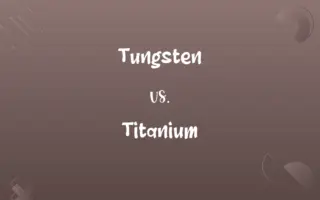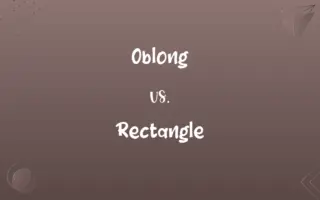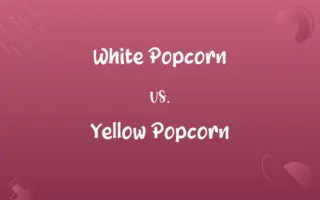Ductility vs. Malleability: Know the Difference

By Hifza Nasir & Dua Fatima || Published on June 16, 2024
Ductility refers to a material's ability to be stretched into wire without breaking, while malleability is about shaping it through compression without cracking.

Key Differences
Ductility is a physical property that allows materials, especially metals, to undergo significant deformation under tensile stress before failure. For example, gold and copper are highly ductile, enabling their use in electrical wiring due to their ability to be drawn into thin wires without breaking. Malleability, on the other hand, concerns a material's ability to deform under compressive forces. This characteristic is crucial for metals that must be shaped or flattened into sheets through hammering or rolling, such as aluminum and silver, which are known for their high malleability.
Dua Fatima
Jun 16, 2024
Both properties are indicative of a material's plasticity, which is a measure of how easily it can be shaped or deformed without cracking. However, ductility is specifically related to tensile (pulling) forces, whereas malleability is associated with compressive (squeezing) forces. This distinction is vital in manufacturing and materials science, where the selection of materials for specific applications depends on their mechanical properties.
Hifza Nasir
Jun 16, 2024
In practical applications, the distinction between ductility and malleability influences the manufacturing processes used for different materials. Ductile materials are preferred for applications requiring elongation, such as cables and wires, while malleable materials are suited for creating objects with broad, thin surfaces, like sheet metal for automotive bodies.
Hifza Nasir
Jun 16, 2024
Understanding the differences between ductility and malleability helps in predicting a material's behavior under stress and determining its suitability for various industrial applications. For instance, a ductile material might be chosen for structural components that are subject to tension, whereas a malleable material would be selected for parts that must be shaped through bending or flattening.
Dua Fatima
Jun 16, 2024
Comparison Chart
ADVERTISEMENT
Ductility and Malleability Definitions
Ductility
Ductility is the ability to stretch material into a wire.
Gold's ductility allows for making thin wires for jewelry.
Dua Fatima
Feb 29, 2024
ADVERTISEMENT
Malleability
Malleability is the capacity to mold material into thin sheets.
Aluminum's malleability is exploited in making foil.
Hifza Nasir
Feb 29, 2024
Ductility
Ductility permits materials to be drawn into long, thin shapes.
Silver's ductility makes it ideal for crafting delicate silver threads.
Hifza Nasir
Feb 29, 2024
Malleability
High malleability means a material can endure compressive forces.
Gold leaf is made possible by gold's extreme malleability.
Hifza Nasir
Feb 29, 2024
Ductility
Ductility is a measure of how a material deforms under tension.
Aluminum shows ductility when stretched into wiring.
Hifza Nasir
Feb 29, 2024
Malleability
A malleable material can be flattened or bent easily.
Lead is used for radiation shielding due to its malleability.
Hifza Nasir
Feb 29, 2024
ADVERTISEMENT
Ductility
A ductile material can undergo significant elongation.
Copper wires are used in electrical cables due to their high ductility.
Hifza Nasir
Feb 29, 2024
Malleability
Malleability allows for the shaping of metals without cracking.
Silver's malleability facilitates the creation of ornate jewelry.
Hifza Nasir
Feb 29, 2024
Ductility
High ductility means a material can withstand tensile stress.
Steel's ductility is critical for constructing flexible bridges.
Dua Fatima
Feb 29, 2024
Malleability
Malleability is a measure of how a material deforms under compression.
Copper plates are formed from the metal's malleability.
Dua Fatima
Feb 29, 2024
Ductility
(physics) Ability of a material to be drawn out longitudinally to a reduced section without fracture under the action of a tensile force.
Dua Fatima
Feb 29, 2024
Malleability
Capable of being shaped or formed, as by hammering or pressure
A malleable metal.
Hifza Nasir
Feb 29, 2024
Ductility
The malleability of something that can be drawing into wires or hammered into thin sheets
Shumaila Saeed
Feb 29, 2024
Malleability
The property of being physically malleable; the property of something that can be worked or hammered or shaped under pressure without breaking
Hifza Nasir
Feb 29, 2024
Malleability
Capable of being changed or adjusted to meet particular or varied needs
The malleable rhythms of jazz.
Hifza Nasir
Feb 29, 2024
Malleability
The property by virtue of which a material can be extended in all directions without rupture by the application of load; a material's ability to be bent, formed, or shaped without cracking or breaking.
Hifza Nasir
Feb 29, 2024
Repeatedly Asked Queries
Can a material be both ductile and malleable?
Yes, many metals exhibit both ductility and malleability to varying degrees.
Hifza Nasir
Jun 16, 2024
What is ductility?
Ductility is the ability of a material to be stretched into a wire without breaking.
Dua Fatima
Jun 16, 2024
Why is ductility important in materials?
Ductility is important for applications requiring materials to undergo significant deformation without failure, such as in electrical wiring.
Hifza Nasir
Jun 16, 2024
How do alloying elements affect ductility and malleability?
Alloying elements can either enhance or reduce these properties depending on the type of material and the added elements.
Hifza Nasir
Jun 16, 2024
What tests measure ductility?
Tensile tests, which apply a pulling force to a material, measure ductility by determining elongation and reduction of area.
Dua Fatima
Jun 16, 2024
Are ductility and malleability only applicable to metals?
While these properties are most commonly associated with metals, certain non-metal materials can also exhibit ductility and malleability.
Shumaila Saeed
Jun 16, 2024
Why is malleability important in materials?
Malleability is crucial for processes that involve shaping materials into sheets or other forms through compression, like in metalworking.
Shumaila Saeed
Jun 16, 2024
How does temperature affect ductility and malleability?
Temperature can significantly influence both properties, generally increasing ductility and malleability with rising temperatures.
Hifza Nasir
Jun 16, 2024
What tests measure malleability?
Compression tests, where a material is subjected to squeezing forces, can indicate malleability by observing the degree of deformation without cracking.
Dua Fatima
Jun 16, 2024
Can ductility and malleability be enhanced through processing?
Yes, processes like annealing can improve both properties by altering the microstructure of the material.
Dua Fatima
Jun 16, 2024
What is malleability?
Malleability is the ability of a material to be shaped or flattened under compressive forces without cracking.
Hifza Nasir
Jun 16, 2024
How do manufacturers utilize malleability?
Manufacturers exploit malleability in metalworking processes to shape metals into desired forms, such as automotive panels or metal containers.
Hifza Nasir
Jun 16, 2024
What is the significance of ductility in seismic design?
In seismic design, ductility allows structures to withstand earthquake-induced stresses by deforming in a controlled manner.
Hifza Nasir
Jun 16, 2024
Is there a relationship between ductility and toughness?
Yes, both ductility and toughness are measures of a material's ability to absorb energy, but toughness additionally involves the material's strength.
Dua Fatima
Jun 16, 2024
What role does ductility play in safety and design?
Ductility is crucial for designing structures and components that can absorb energy and deform under stress without sudden failure.
Hifza Nasir
Jun 16, 2024
Share this page
Link for your blog / website
HTML
Link to share via messenger
About Author
Written by
Hifza NasirCo-written by
Dua Fatima



































































